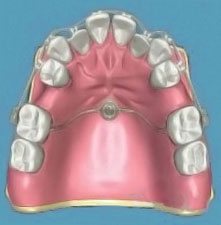(advertisement)

Orthordontic Dental Implants
In conventional implant dentistry, dental implants function as natural tooth roots providing adequate support for the replacement teeth, but in recent years they have become highly significant in orthodontic treatment, with their use increasing greatly over the last decade. Their greatest feature is the capability for full integration (osseointegration) with the jawbone providing a solid anchor point which an orthodontic appliance can be fixed.
In traditional dental implantology, an extension is fixed to the implant and then a new crown is fixed on it that resembles natural teeth. Dental implants can be used to replace one tooth or multiple of teeth. They are best suited for individuals who have lost most or all of their teeth, but have sufficiently thick jawbone to hold the implants.
Studies of Orthodontic Treatment with Implants
A study released by AAID (American Academy of Implant Dentistry) in their 2011 annual meeting has highlighted the way dental implant usage is improving the effectiveness of orthodontic treatment. The capacity of implants to provide solid anchorage has made it possible to shorten the treatment time, while also facilitating treatment of problems previously considered untreatable.
Another important study in this direction is the one done by a team of research scientists lead by Professor Frank Celenza at the New York University College of Dentistry. This study also brought to focus the immense potentiality of dental implants in simplifying orthodontic treatment and making it more effective. The treatment time with dental implants used for anchorage could be reduced by about 30%. It also helps the orthodontist accurately predict and control the movement of the teeth. Since dental implants are anchored to the bone, they are more stable than previous anchoring methods such as headgear, adjacent teeth, elastics and other appliances that necessitated patient compliance.
(advertisement)
When are Implants Used in Orthodontics?
It is now possible for orthodontists to evaluate patients with extensive orthodontic problems and determine whether treatment using implants will be effective in their case.
For orthodontic treatment ‘root form’ dental implant are used; this is a screw type implant that acts as a tooth root. This implant is recommended when the patient has sufficient width and depth for the jawbone. In some patients whose jawbone is insufficient, the dentist may prescribe bone grafting before the implants can be placed.
Dental implants are usually having a diameter of 3 ½ to 8 mm and a length of 11 to 21 mm. To place the implant, at least 8 mm space is required between the healthy teeth of the patient. Once the implants are placed, a 3 – 6 month period is needed for osseointegration to take occur. After the healing period, an abutment is placed on the implant to which the orthodontic device will be anchored.
Orthodontic treatment has become more effective and promising with the introduction of dental implant technology. It is indeed a challenging procedure, but has tremendous potential to address a variety of teeth conditions. An experienced and qualified dental surgeon can provide result-oriented treatment that will gift patients with an improved smile and facial structure.
References
“Absolute anchorage in orthodontics: direct and indirect implant-assisted modalities” by F Celenza, M N Hochman. Published in the Journal of clinical orthodontics JCO (2000) Volume: 34, Issue: 7, Publisher: JCO, INC., Pages: 397-402. Available in full from http://www.frankcelenza.com/publications/Direct.pdf
“Orthodontic considerations in restorative management of hypodontia patients with endosseous implants” by Ali Borzabadi-Farahani. Journal of Oral Implantology In-Press. July 5, 2011.
(advertisement)
Mark Jerome is an author who specializes in dental surgery in the many different innovations and applications of dental. He works with www.dentalcareplus.org.uk which is a leading dental surgery provider in England. Visit the site to discover more about dental implantology and further specific information can be provided by asking one of their dentistry experts at www.dentalcareplus.org.uk/ask-an-expert.htm.
(advertisement)

